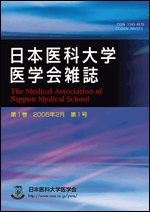Volume 13, Issue 2
Displaying 1-11 of 11 articles from this issue
- |<
- <
- 1
- >
- >|
-
2017Volume 13Issue 2 Pages 61
Published: April 15, 2017
Released on J-STAGE: April 28, 2017
Download PDF (266K)
Photogravure
-
2017Volume 13Issue 2 Pages 62-63
Published: April 15, 2017
Released on J-STAGE: April 28, 2017
Download PDF (478K)
-
2017Volume 13Issue 2 Pages 64-70
Published: April 15, 2017
Released on J-STAGE: April 28, 2017
Download PDF (349K) -
2017Volume 13Issue 2 Pages 71-78
Published: April 15, 2017
Released on J-STAGE: April 28, 2017
Download PDF (337K)
Review
-
2017Volume 13Issue 2 Pages 79-87
Published: April 15, 2017
Released on J-STAGE: April 28, 2017
Download PDF (1239K) -
2017Volume 13Issue 2 Pages 88-96
Published: April 15, 2017
Released on J-STAGE: April 28, 2017
Download PDF (1465K)
-
2017Volume 13Issue 2 Pages 97-100
Published: April 15, 2017
Released on J-STAGE: April 28, 2017
Download PDF (382K)
Nurse’s Series
-
2017Volume 13Issue 2 Pages 101-103
Published: April 15, 2017
Released on J-STAGE: April 28, 2017
Download PDF (199K)
Talking Point
-
2017Volume 13Issue 2 Pages 104-105
Published: April 15, 2017
Released on J-STAGE: April 28, 2017
Download PDF (163K)
-
2017Volume 13Issue 2 Pages 106-107
Published: April 15, 2017
Released on J-STAGE: April 28, 2017
Download PDF (216K)
-
2017Volume 13Issue 2 Pages 108-109
Published: April 15, 2017
Released on J-STAGE: April 28, 2017
Download PDF (272K)
- |<
- <
- 1
- >
- >|
